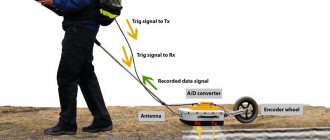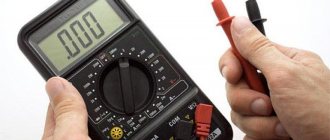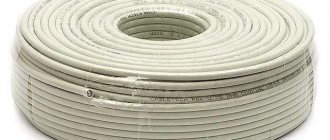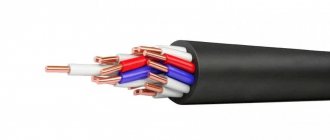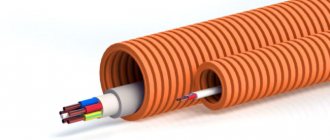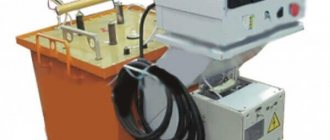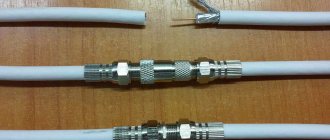How to find the location of cable damage underground?
The operation of underground power and telecommunication cables is associated with carrying out scheduled and repair measurements, as well as localizing damage in cable lines.
During routine measurements, primary parameters are often checked: insulation resistance, loop resistance, asymmetry. Often a bridge meter is sufficient for these jobs.
Repair and restoration work is a more labor-intensive process that requires well-trained specialists and a wide range of equipment. Localization of the defect requires the following actions:
Determination of the presence of a defect and its identification (water in the cable, broken pair or core, insulation damage, short circuit, transient interference, noise, mixed-up pairs, parallel taps, etc.)
Determination of the distance to the defect (using the bridge or reflectometric method).
Localization of damage on the ground using path detectors or cable locators.
Basic proposal for locating damage to power cables laid in the ground
The basic fault location offer is suitable for all types of power cables laid in the ground and cable ducts. Determining the location of a fault in a cable laid in the ground means searching for a point on the surface under which the sought-for fault is located .
Finding the location of cable damage
Description: Search for the location of damage to a power cable with voltage up to 10 kV laid in the ground, drawing up a Protocol for determining the location of the damage and making a Decision on the scope of excavation work necessary to repair it
Note: The completed Protocol for determining the location of cable line damage is certified by the round seal of the electrical laboratory and is issued to the Customer directly at the work site. If necessary, subsequent processing is possible - transfer of WMD Protocol data to a geo-base, satellite image, etc.
Initial data: Access to one of the ends of the damaged cable, access to the cable line route (preferably a laying plan). At the opposite end the wires must be open
Cost: 15000 RUB
The operations performed by the electrical laboratory after opening the trench are called confirmation of the location of cable damage and are not included in the Basic offer.
There is an important nuance in providing the service of searching for the location of a fault on a 0.4/10 kV cable line:
You can make sure that the damage is located exactly where the electrical laboratory indicated only after opening the cable route, which in itself requires time and money.
The question of primary importance here is whether the opening of an Excavation Work Order is required .
Finding a broken hidden wiring in a concrete wall
A special device - a locator - will help you find the location of a wire break in a concrete wall. It is a combination of a receiver and an oscillator. This method can be associated with the induction method in searching for cable faults underground.
So, determining the location of the break with a route finder is not difficult. The end of the wire in which there is a break is connected to a generator, which sends pulses of a certain frequency into it. By passing the frame over the place where the wiring is laid, the sound that is formed as a result of the influence of impulses will be clearly audible in the headphones. As soon as the sound disappears, mark this place on the wall - this will be the point of damage to the wire.
A non-contact voltage indicator will also help you find a break in a phase wire. Everything is simple here. We move the device along the wall until the voltage indicator stops lighting. We run the device several times in a circle in this area of the wall to make sure that we have not left the route of the wires. The absence of light on the indicator will indicate the approximate location of the break.
In conclusion, I would like to note that a locator and a non-contact voltage indicator can be used to search for damage to wiring under plaster or under drywall.
Finally, we recommend watching a useful video on finding short circuits in wiring:
So we looked at the most well-known methods for finding the location of cable damage. We hope the information was useful and interesting for you!
We also recommend reading:
Passive method:
If the power cable is under load, voltage is applied to it and electric current flows through it, the use of a passive location method is allowed.
An electric current flowing through the cores of a power cable creates an electromagnetic field with a frequency of 50 Hz around it. This field can be detected by the locator receiver. In this case, the locator generator is not used at all.
This method is simple, but not always effective. With its help, it is easy to determine that there is a cable underground, but it is not possible to distinguish one cable from another. The signal from all power cables will have the same frequency.
Laying cables under the road
If the route is located in such a way that it must be built under a road, you will have to obtain permission from the organization that owns this road. This point is mandatory in populated areas, since there may be other communications under the road and they can be damaged by unauthorized work. If we are talking about a dacha and a holiday village, then it must be agreed with the administration of the village.
A puncture under the road is made using special equipment
The rules for laying cables under the road do not change - trench depth is 70-80 cm, sand cushion and backfill, laying in an asbestos-cement pipe or double-wall corrugated DCS is desirable. In general, there are no differences, all the rules and regulations are the same.
Difficulties may arise if it is necessary to lay cables under asphalt. If it’s a solid road, you’re unlikely to be allowed to destroy the surface, and if they do, restoring the asphalt is an expensive proposition. In this case, there is also a way out - there is special equipment that is used to make a puncture under the road. The service is also not cheap, but it costs much less than the cost of asphalt restoration.
Cost of determining the location of power cable damage
The price we set for determining the location of damage to a cable line laid in the ground depends on:
- Type of damage
- Length of cable line
- Distance from Moscow
We recommend opening the cable line route immediately , in the presence of specialists from the laboratory that determined the location of the damage. This will allow you to carry out all the work in one visit, which means confirming the location of the damage will cost you almost free.
Reasons for broken wiring
One of the main reasons for wiring breakdowns is its wear and tear, which is typical for old wiring that has not been replaced for a long time. Each cable has its own service life depending on the conditions of use; there is no eternal electric cable. Outdated wires are often destroyed, twists in boxes are broken, which can lead to leaks, and the residual current device, if installed, often trips. In the absence of such a device, the leakage will increase and ultimately the electricity will disappear.
The cable is often destroyed during repair and construction work, namely due to careless and inaccurate drilling. When carrying out such work, the wire may be completely or partially damaged. As a result, sockets or switches do not work, although there is voltage in the network. There are also cases when a screw is screwed into the wiring or a nail is driven in. This situation is much more serious and can result in a short circuit. Again, if a residual current device is installed, it will often trip, but if it is missing, the wiring will begin to smoke and spark, which can lead to a fire. Very often, the consequences of damage to wiring during repairs do not appear immediately, and this greatly complicates the process of finding the location of the break.
Causes and types of damage to cable lines
There are many factors that negatively affect the integrity of power cables, the most common of which include the following:
- Ground movement can be caused by a failure of water supply, sewer or heating networks, as well as seasonal phenomena, for example, spring thawing.
- Exceeding the permissible operating standards for cable lines, which can lead to thermal overload of the line caused by an increase in current load.
- Formation of a high level of electric current in the cable line from a transit short circuit.
- Mechanical damage during excavation work without taking into account the passage of underground communications and the depth of the route.
- Errors when laying cable lines. As an example, we can cite violations of the technology for connecting cores with cable couplings.
- Manufacturing defects.
Note that when cable routes are laid open, some of the above causes of damage are extremely rare. In particular, the likelihood of the influence of soil movement and mechanical impacts due to excavation work is reduced. In addition, damage zones of open cable lines, in most cases, can be detected by visual inspection, without the use of special methods.
Having dealt with the reasons, let’s move on to the types of damage, since this directly determines the method by which the emergency section of the cable line will be localized.
Most often, repair teams have to deal with the following types of faults:
- A defect caused by a complete or partial break of a cable line. Most often, the cause of the accident is excavation work without determining the passage of cable routes. Somewhat less frequently, the cause of this damage can be a short circuit in the couplings.
- In power cables (more than 1 kV), breakdown of one of the conductors to ground (single-phase short circuit) is often encountered. Leakage current, as a rule, is caused by a decrease in the quality of insulation during operation of the cable line.
- Interphase damage, as well as types of metal short circuits, can occur in any lines; the cause of damage is the same as in the previous paragraph.
- Routine cable testing, which involves high voltage levels, shows low insulation reliability and leads to breakdown. Under certain circumstances, such a line can continue to operate, but due to its low level of reliability, an accident can occur at any time.
How to find a metal pipe in the ground yourself
All of the above methods are suitable for searching for metal pipes, but a locator is the most convenient and preferred option. In some cases, it will determine with the highest accuracy the required underground networks even in passive mode (without using a signal generator); such pipelines include heating networks and gas pipelines, because They often have a protection current.
In the case of metal, another option appears - a metal detector. Despite the dependence on third-party interference and limitations on the depth of work, it has a number of advantages:
- availability;
- ability to identify cast iron pipes with non-metallic connections;
- relative ease of learning operating modes during independent probing.
As for searching for pipes underground on your own, this is of course possible - almost all equipment can be rented. In contrast to this idea, you can note: firstly, you will have to spend significant time studying the instructions, and in the case of ground penetrating radar you will most likely need small courses, and secondly, the amount of the deposit will be a very powerful argument against it.
Determining the exact location of the break
After a break has been found with a multimeter, you should determine exactly where it happened. To make your task easier, you should remember that the wiring can be located inside the system, strictly horizontally or vertically. Under the wallpaper, you can visually determine the location of the grooves by small swellings. If these swellings go to the location of the switch or sockets, electrical wiring is hidden under them.
How to determine the location of the fault if the visual detection method is not suitable? You can use such an inexpensive device as a cable tracker. These devices are also called testers/trackers, dialers. The kit includes two devices - a signal generator (emitter) and a receiver (receiver). The generator is connected to the wire being tested using crocodiles. The receiver will indicate with great accuracy where the wiring is located. It can also be used to check the integrity of computer and telephone network wires.
After discovering the cable laying, it should be released from the groove and the faulty piece going to the junction box should be replaced. It may be that there is no voltage inside the box itself. Then you need to look for and check the wire that is laid from the electrical panel to the distribution box. The sequence of actions is the same.
Source: normdom.ru
Installation of VSSK coupling for 10 pairs
Cable preparation (cable TPPepZ 10*2*0.5).
We clean and degrease the cable sheath from both ends to 250 mm.
Repairing cable shield
It is necessary to insert the base of the screen connector under the cable sheath, between the screen and the belt insulation of the cable until it stops against the edge of the sheath. Lightly tap the shell so that the teeth engage the shell. Place the cover on the base screw and tighten both parts with one nut.
On cables with an outer diameter of less than 20 mm, a 25 mm long sheath cut must be made on the side diametrically opposite to the screen connector.
Lay the cable underground at the dacha using underground power lines
Many country homeowners are interested in how to lay a cable underground in their country house. The prices for underground cable laying are quite high, which is caused by the need for excavation work. There are two ways to lay a cable in the ground. A suitable technical solution is selected depending on the installation conditions and project features.
Power wires can be laid in a special sewer, which is an underground pipeline, or simply buried in a trench. Many people ask the question of how to lay a cable underground from a pole to a house in a pipe if there is a lot of moisture. In such cases, the fundamental criterion is safety: it is necessary to create reliable waterproofing and prevent possible contact of the wiring with a damp environment. This task is successfully accomplished by installing pipeline communications on the site.
Methods for determining cable damage in the ground
To find the location of the cable line damage, you need to understand the specifics and methodology of the search. The process must be divided into two stages:
- Search for problem areas along the entire length of the line.
- Searching for an accident site on a designated section of the highway.
Due to the differences between these two stages, the search methods themselves differ and are:
- relative (remote) - these include the pulse and loop methods;
- absolute (topographic) - acoustic, induction and step voltage method.
Well, let's look at all the methods in order.
Pulse method
This method involves searching for damage using a reflectometer. Work can be carried out, for example, with the REIS-305 device, which is shown in the photo below.
The operation of the device is based on sending probing pulses of a certain frequency, which, when encountering an obstacle in their path, are reflected and returned back to the device. That is, the device is located at one end of the power cable, which is very convenient and practical. To calculate the exact distance to the damage site, you must use the following formula:
Where, according to the formula, L is the length of the cable from the point of connection of the device to the fault, tx is a variable value of the amount of time spent for the pulse to reach the point of break and back. υ – the speed with which the pulse travels along the cable (for cable lines from 0.4 kV to 10 kV it is 160 m/µs).
This method can detect not only a break in the power cable, but also a short circuit between the wires. To understand what happened, let's look at the image on the screen during the tests. The pictures will be like this (short circuit on the left, open circuit on the right):
Tests should be carried out on a completely disconnected line. The video example clearly demonstrates how to use a short circuit finder:
Loop method
This method is applicable provided that at least one wire in the cable remains intact, or another conductor with intact cores lies nearby. To find out the distance to the place of damage using the loop method, you need to measure the DC resistance of the wires with the P333 device. This is a DC measuring bridge that looks like this:
Before starting measurements, we connect the end of the intact and damaged core with a short circuit, and connect the other two ends according to the diagram:
You can calculate the distance to the point at which the break occurred using the following formula:
- R1 - resistance that is connected to the whole core;
- R2 – resistance that is connected to the open wire;
- L – cable length to the point of damage;
- Lк – length of the entire conductor.
This is perhaps one of the first invented methods used to find the location of the fault, and it is used exclusively for single-phase and two-phase faults. Gradually they stop using it, due to its labor intensity and large error in measurements.
Acoustic method
You can find a break in a cable using the acoustic method by creating a discharge at the site of damage using a high-voltage pulse generator (in the picture below). At the location of the break or short circuit, sound vibrations of a certain frequency will appear. The quality of listening depends on the type of soil, the distance from the surface to the cable line and the type of damage. A prerequisite for the method to work is to exceed the contact resistance value of 40 ohms.
An example of searching for a damaged line using an acoustic method is provided in the video:
Step Voltage Method
The method is based on passing current generated by a generator through a cable. It creates a potential difference between two points located in the ground, which can be judged by the current leakage at the site of the accident. To find a point with reduced insulation resistance, contact probe probes are installed like this - the first one is exactly above the running conductor, the second one is at an angle of 90 0, a meter from the first one.
The point where the cable is damaged is under the first pin, assuming the signal is at its maximum. You can learn more about step voltage from our article!
Induction method
The method very accurately determines the location of the break, but its use is associated with burning the cable. If the transition resistance is large, it is necessary to reduce its value by burning, using special devices, for example, the VUPK-03-25 cable burning installation:
The method is based on passing a high-frequency current through the core, which forms an electromagnetic field above the cable line. In places of mechanical damage to the route, passing the receiving frame, the sound will change. Thus, the absence of sound indicates a wire break.
The video below clearly demonstrates the location of the emergency area by burning:
